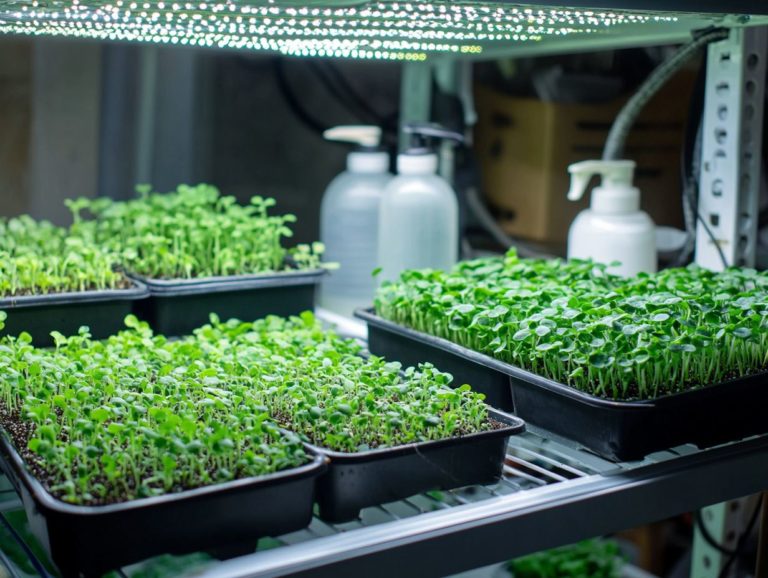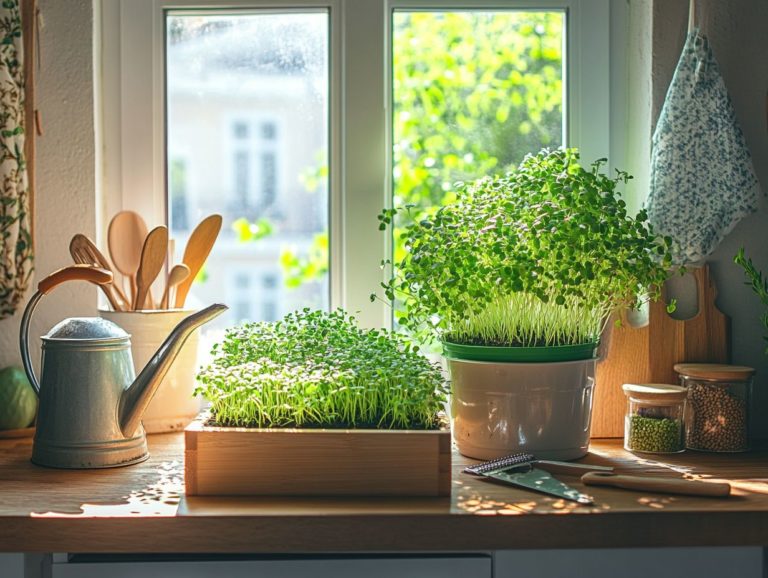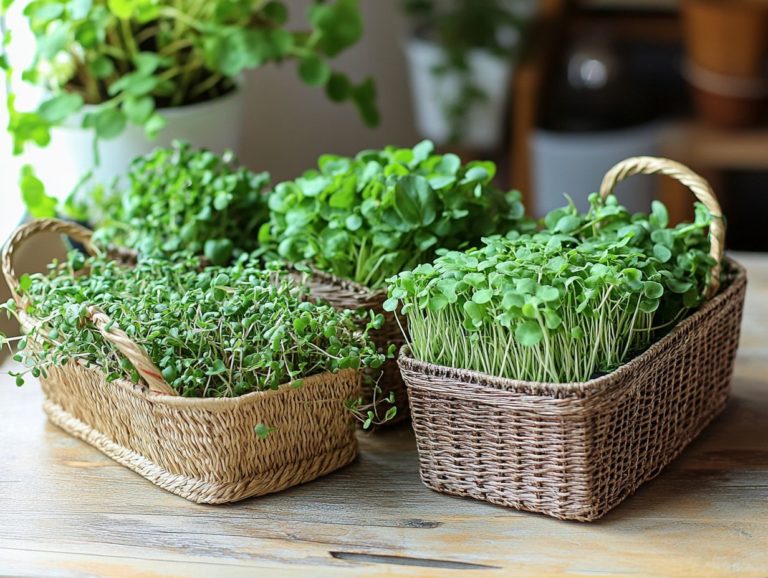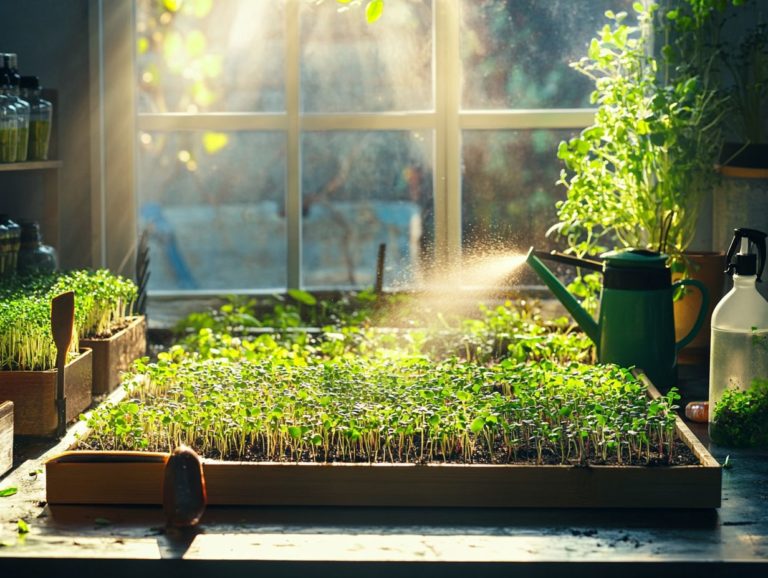Top 5 Automated Systems for Microgreens
In the dynamic realm of agriculture, automation is revolutionizing the way you cultivate crops, especially microgreens. These nutrient-packed powerhouses are not just a favorite among health aficionados; they also offer a lucrative opportunity for growers eager to enhance efficiency and yield.
Get ready to discover the top five automated systems tailored specifically for microgreen production, covering essentials like watering, lighting, temperature control, and harvesting.
You ll also explore the many benefits of automation, essential features to keep in mind, and guidance on selecting the right systems for your business.
Dive in to uncover how these innovations can elevate your microgreen farming game.
Contents
- Key Takeaways:
- 1. Automated Watering Systems
- 2. Automated Lighting Systems
- 3. Automated Temperature Control Systems
- 4. Automated Nutrient Delivery Systems
- 5. Automated Harvesting Systems
- Discover What Microgreens Are and Their Growing Popularity!
- How Can Automation Benefit Microgreen Production?
- What Are the Different Types of Automated Systems for Microgreens?
- What Are the Key Features to Look for in an Automated System for Microgreens?
- What Are the Costs Associated with Implementing Automated Systems for Microgreens?
- How Can a Business Determine Which Automated Systems Are Best for Their Microgreen Production?
- Frequently Asked Questions
- 1. What are the top 5 automated systems for growing microgreens, including Freshsprout Farms and Urban Greens?
- 2. How does the Urban Cultivator work as an automated system for growing microgreens?
- 3. Can the Click & Grow Smart Garden grow microgreens as an automated system?
- 4. What makes the AeroGarden a top automated system for microgreens?
- 5. Is the Sprout Garden suitable for commercial use as an automated microgreens system?
- 6. How does Farm.One’s automated system for microgreens differ from the others on this list?
Key Takeaways:
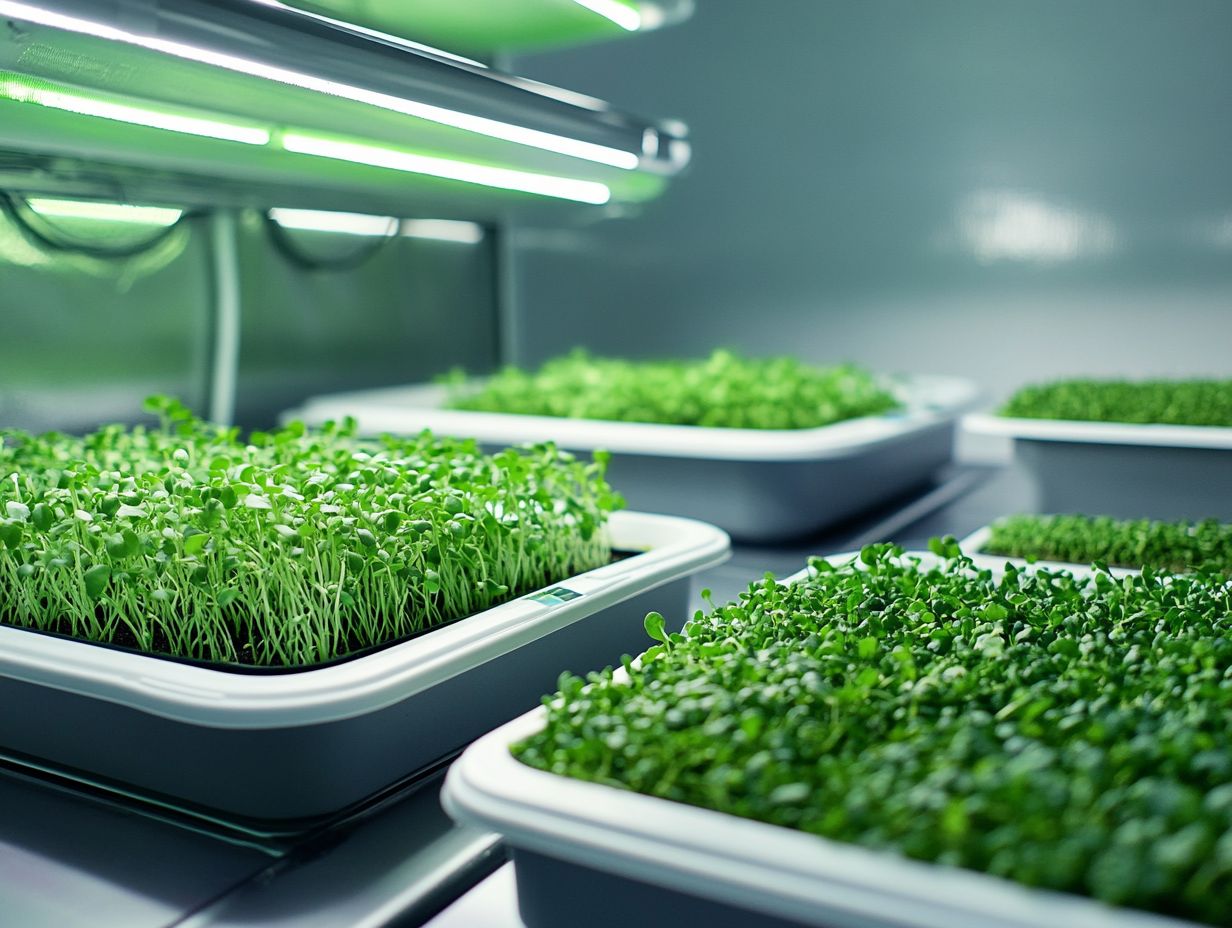
- Automating watering, lighting, temperature control, nutrient delivery, and harvesting can benefit microgreen production by increasing efficiency and consistency, ultimately supporting sustainable practices in farming.
- The key features to look for in an automated system for microgreens include ease of use, reliability, and customizable settings.
- Implementing automated systems for microgreens can come with initial costs, but the long-term benefits of increased productivity and reduced labor costs make it a worthwhile investment.
1. Automated Watering Systems
Automated watering systems are essential for your microgreen farming endeavors. They optimize moisture content and ensure consistent hydration, enhancing both crop quality and yield within controlled environment agriculture settings.
These advanced technologies utilize sensors and timers to monitor soil moisture levels, delivering precise amounts of water exactly when your plants need it. In hydroponic systems, such innovations are vital, facilitating effective water and nutrient uptake essential since microgreens thrive in soil-less environments.
Your automated systems can range from straightforward drip irrigation to more sophisticated setups employing nutrient film techniques or aeroponic systems. Simply put, these methods allow you to significantly reduce water waste while fostering healthier plant growth. Additionally, when growing microgreens, it’s essential to consider the top pest control supplies to ensure optimal results.
The impact on moisture management is substantial; maintaining optimal hydration minimizes the risk of root rot and enhances nutrient absorption, ultimately leading to improved yields in your sustainable microgreen production.
2. Automated Lighting Systems
Automated lighting systems, especially those featuring energy-efficient LED grow lights, are fundamental to your microgreen farming success. They create optimal growth conditions, ensuring your plants receive consistent light exposure, which is vital for their health and effective crop monitoring.
These systems also address the specific light needs of various microgreens, fostering robust growth and enhanced flavor. They adjust dynamically as the plants progress through their developmental stages, leveraging data monitoring tools for precision.
By employing sensors and smart controls, sophisticated setups can fine-tune the intensity and duration of light as required, maximizing your yields while keeping energy consumption low.
Companies like Greentech and Urban Crop Solutions have effectively harnessed these technologies, showcasing remarkable improvements in growth rates and resource efficiency. With LED technology integrated into these automated systems, you can achieve the perfect light spectrum, boosting nutrient content and overall quality, making your produce even more enticing to consumers.
3. Automated Temperature Control Systems
Automated temperature control systems are essential for maintaining the ideal growing conditions for your microgreens, ensuring that temperature fluctuations never compromise crop quality in urban agriculture environments.
These sophisticated systems employ advanced technologies like thermostats, sensors, and software algorithms to continuously monitor and fine-tune the environment where these delicate plants thrive. By regulating temperature, they establish an optimal biosphere that fosters healthy germination and growth.
Smart sensors can activate cooling or heating units at just the right moments, preventing stress on the plants caused by sudden temperature shifts. This level of control not only bolsters plant health but also enhances nutrient uptake and overall crop yields, enabling you to achieve consistent results even in the most challenging conditions.
Consider implementing these automated systems to take your microgreen farming to the next level. To avoid common pitfalls, be sure to check out the top 5 mistakes in growing microgreens. Act now and see the difference it can make for your business!
4. Automated Nutrient Delivery Systems
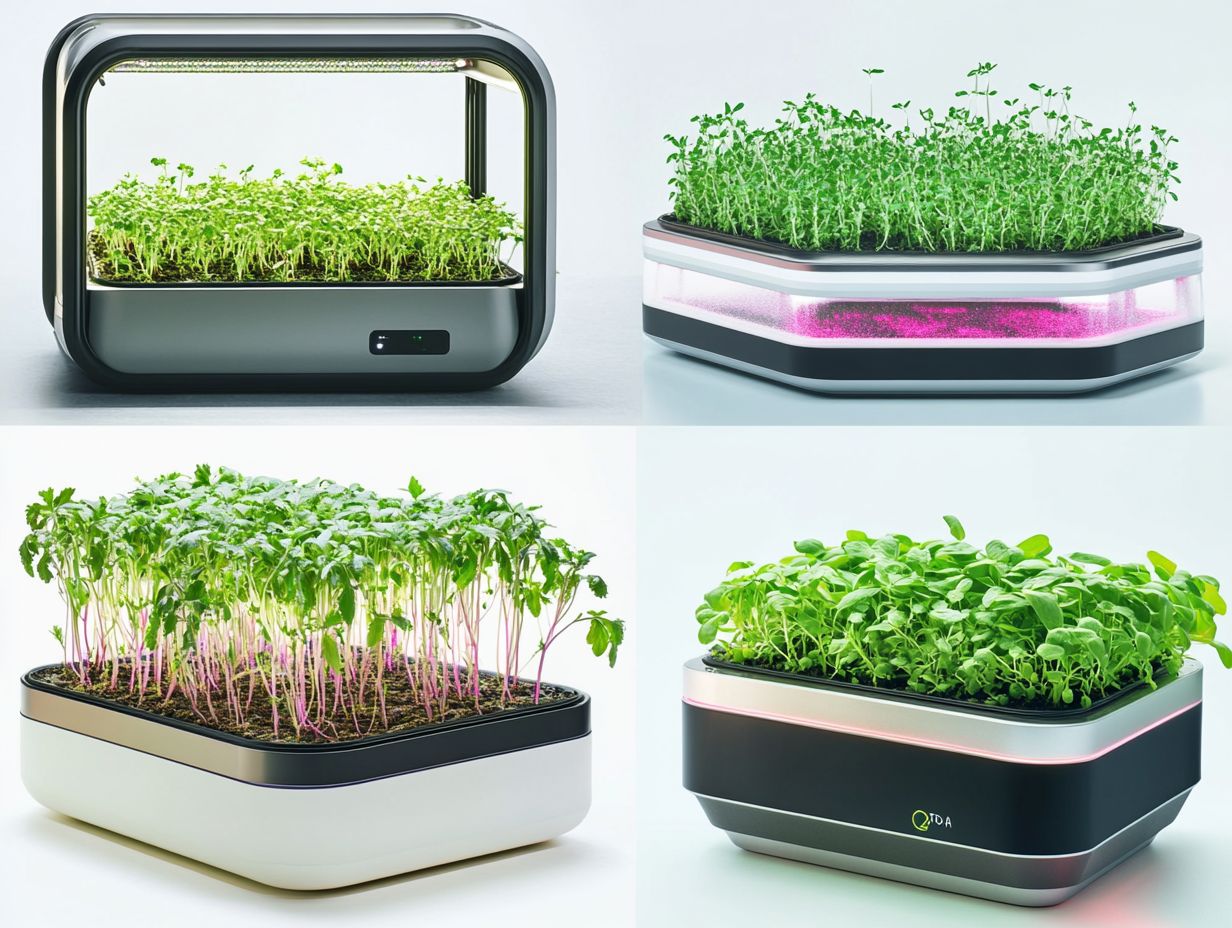
Automated nutrient delivery systems are essential for your microgreen farming. They enable precise nutrient management and effective delivery of nutrient-rich solutions, enhancing both growth rates and crop quality.
These systems ensure your microgreens receive a balanced mix of essential nutrients at the right stages of development. This optimizes their growth potential.
By automating the nutrient application process, you can reduce labor costs and minimize human error. This leads to cleaner and more consistent yields.
The nutrient solutions you apply not only boost flavor profiles but also enhance nutritional content, making your microgreens more attractive to health-conscious consumers. When paired with organic seeds, you promote sustainable farming practices that contribute to a healthier environment while keeping your microgreens free from synthetic pesticides and fertilizers.
5. Automated Harvesting Systems
Automated harvesting systems are transforming microgreen farming, making it more efficient and cost-effective while maintaining crop quality and improving yields.
These systems use advanced technologies like robotics, AI-driven analytics, and sensors that accurately measure conditions to streamline the harvesting process. By using automated machinery to monitor plant growth, you can significantly reduce waste.
These technologies are crucial for maintaining plant health, allowing for the swift removal of only mature greens and preventing damage to surrounding foliage.
The result is not just improved produce quality but also a more sustainable farming approach that maximizes productivity while preserving valuable resources.
Discover What Microgreens Are and Their Growing Popularity!
Microgreens are young vegetable seedlings harvested at an early stage, celebrated for their vibrant flavors and impressive nutritional value. They re becoming a must-have for those who care about health and culinary delights.
These tiny greens pack a nutritional punch that often surpasses that of their mature counterparts. Their peppery or sweet flavors can elevate your dishes, transforming ordinary salads and sandwiches into gourmet delights.
Cultivating microgreens is not only beneficial for your health; it s a step toward sustainability. They require minimal space and resources, making them ideal for urban environments. Plus, their rapid growth cycles mean even novice gardeners can enjoy fresh produce in just a few weeks, enhancing both their diet and the local food scene.
How Can Automation Benefit Microgreen Production?
Embracing automation in microgreen production brings numerous benefits, including optimized yields, minimized resource waste, and heightened efficiency essential factors in meeting rising consumer demand in urban agriculture.
These advancements include automated irrigation systems, climate control units, and monitoring sensors that fine-tune light exposure and nutrient delivery. By adopting precision farming methods, you can track growth conditions meticulously, ensuring your plants receive exactly what they need while reducing unnecessary consumption of water and fertilizers. Additionally, it’s important to avoid the top 5 mistakes in microgreen equipment choices to optimize your setup.
These innovations foster sustainability and simplify labor-intensive tasks, allowing you to use your time and resources more effectively. With data analytics tools at your disposal, you gain actionable insights to make informed decisions about crop rotations and enhance overall productivity.
Don’t wait adopt these technologies now to stay competitive in the evolving landscape of microgreen farming!
What Are the Different Types of Automated Systems for Microgreens?
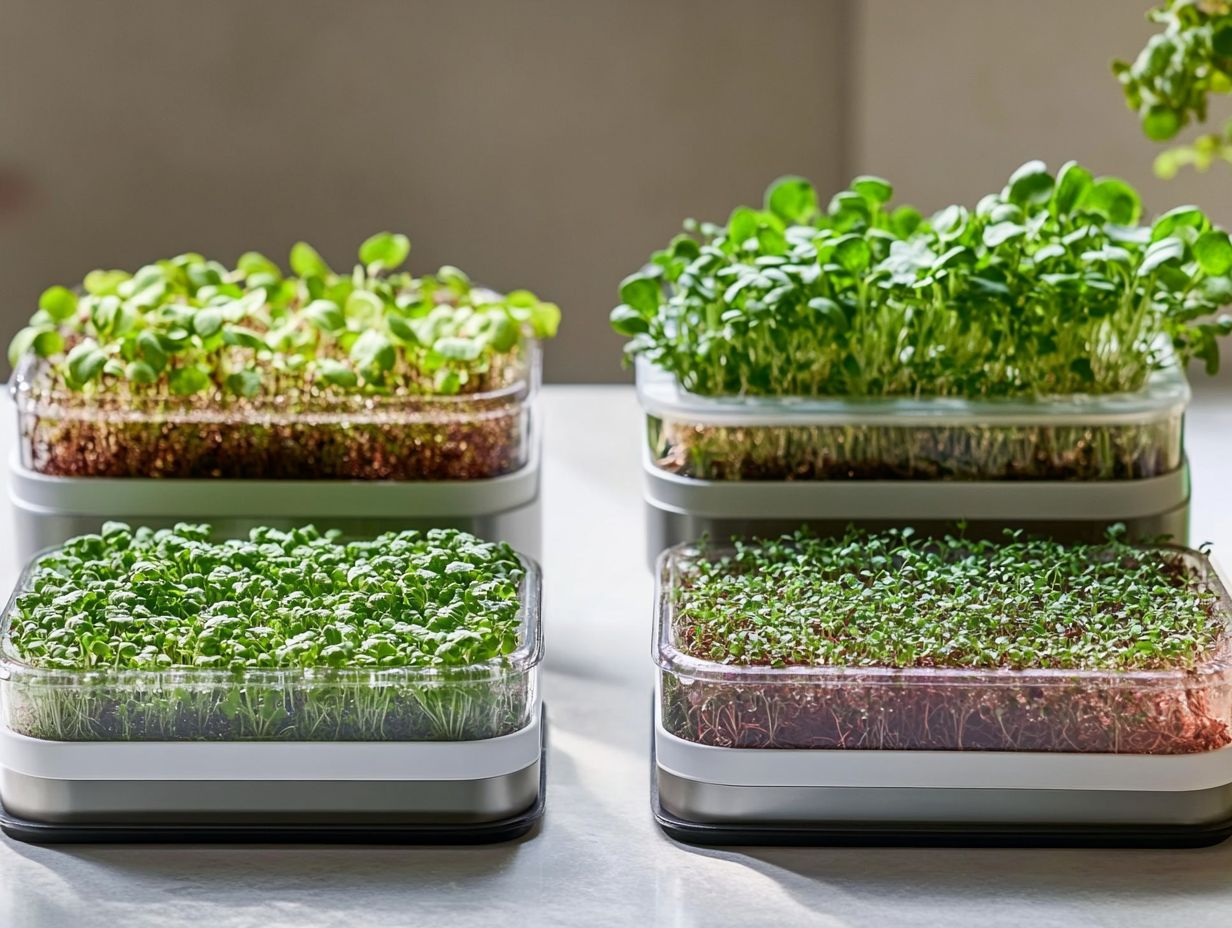
Imagine a world where various automated systems come together to revolutionize your microgreens experience. Hydroponic systems, climate control systems, and nutrient delivery systems each play a distinct role in enhancing your overall production efficiency.
Take hydroponic systems, for instance. They leverage nutrient-rich water-based solutions, enabling your plants to thrive faster and healthier all without the hassle of soil.
Then there are climate control systems that meticulously monitor temperature, humidity, and light. They maintain the optimal growing environment for your microgreens by adjusting automatically based on real-time data. For those looking to maximize their harvest, knowing the top 5 microgreens for easy harvesting can be incredibly beneficial. This ensures your plants are always in their ideal conditions, thanks to advanced data monitoring technologies.
Nutrient delivery systems take your gardening to the next level by dispensing the perfect amount of nutrients precisely when needed. This minimizes waste and guarantees your plants receive what they require for robust growth.
Together, these technological advancements streamline your growing process and significantly boost your yields. This makes microgreen farming accessible and sustainable for everyone, from novices to seasoned growers.
What Are the Key Features to Look for in an Automated System for Microgreens?
When choosing an automated system for microgreens, there are several key features to consider. Think about accurate farming features, smart sensors for data monitoring, and systems specifically designed to enhance yield under controlled conditions.
These elements are crucial for creating an optimal environment for your microgreens, ultimately enhancing their health and growth rate. To achieve this, consider investing in the top greenhouses for microgreen growing. Accurate farming allows you to tailor nutrient delivery and resource allocation, making every drop of water and every gram of fertilizer work harder for you.
Smart sensors continuously monitor important variables like light intensity, humidity, and soil moisture. They automatically adjust conditions to keep everything within ideal growth parameters. Systems engineered for yield improvement use data to predict growth cycles, enabling you to maximize productivity while reducing waste.
This blend of advanced technology ensures your microgreens not only thrive but also result in a healthier product and a more efficient growing operation. For those just starting out, consider exploring the top 5 microgreen kits for beginners.
What Are the Costs Associated with Implementing Automated Systems for Microgreens?
Setting up automated systems for microgreens involves various costs, but the benefits are worth it! Consider the initial investment in technology, ongoing maintenance expenses, and the potential savings from increased efficiency and resource management.
By meticulously analyzing these costs, you can appreciate how the efficiencies gained through automation can significantly offset those initial expenditures. The capital you invest in advanced technologies ranging from climate control systems to automated irrigation might seem overwhelming at first glance. However, these innovations streamline labor demands and optimize growth conditions, ultimately enhancing your yield.
Over time, the reduction in labor costs and the improved utilization of resources can yield substantial financial benefits. This allows you to reinvest in sustainable practices, further boosting productivity and profitability in your microgreen operations.
Ready to transform your microgreen farming? Discover your options today!
How Can a Business Determine Which Automated Systems Are Best for Their Microgreen Production?
To identify the best automated systems for your microgreen production, start by evaluating your specific needs and budget constraints. Consider the outcomes you desire, focusing on yield optimization and resource management. This assessment helps you understand how various technologies can enhance overall efficiency.
By analyzing your current workflows and pinpointing bottlenecks, you can uncover areas ripe for improvement. Start exploring the best automation tools that fit these needs while aligning with your budget and integrating smoothly with your existing practices.
Technology should enhance your production potential, not just replace manual efforts. Make sure these systems match your overall business goals, so every investment becomes a strategic step toward sustainable growth.
Frequently Asked Questions
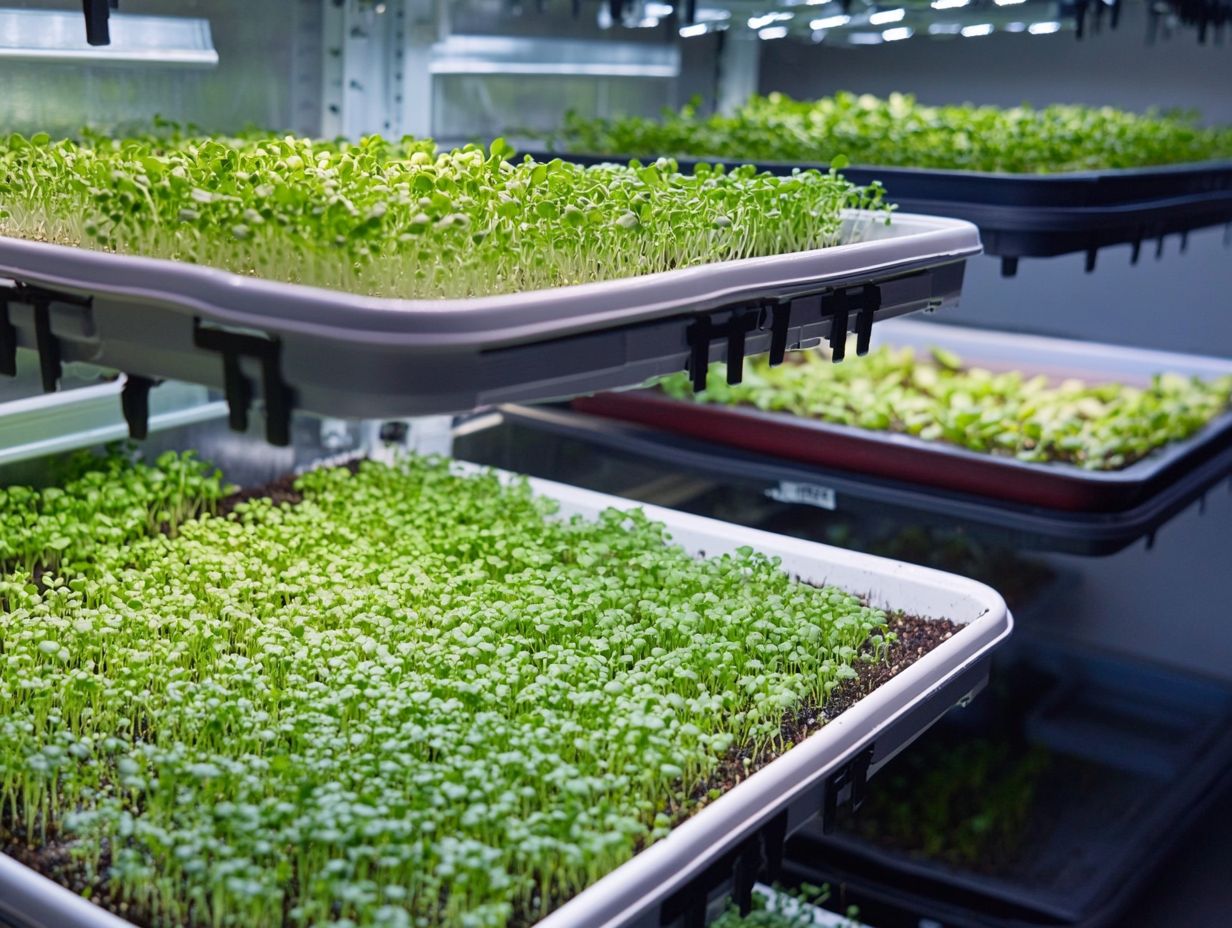
1. What are the top 5 automated systems for growing microgreens, including Freshsprout Farms and Urban Greens?
The top 5 automated systems for growing microgreens are the Urban Cultivator, Click & Grow Smart Garden, AeroGarden, Sprout Garden, and Farm.One.
2. How does the Urban Cultivator work as an automated system for growing microgreens?
The Urban Cultivator is a self-contained indoor garden that uses hydroponics to grow microgreens. It features automated watering, lighting, and temperature controls for optimal growth.
3. Can the Click & Grow Smart Garden grow microgreens as an automated system?
Yes, the Click & Grow Smart Garden is designed to grow various plants, including microgreens. It has a self-watering system and adjustable LED lights for growth.
4. What makes the AeroGarden a top automated system for microgreens?
The AeroGarden uses hydroponics and LED grow lights to create perfect growing conditions for microgreens. It also has a user-friendly control panel for easy customization.
5. Is the Sprout Garden suitable for commercial use as an automated microgreens system?
The Sprout Garden is designed for home use but can also be used in small commercial settings. It features automated watering and lighting, making it convenient for larger-scale microgreen production.
6. How does Farm.One’s automated system for microgreens differ from the others on this list?
Farm.One offers a subscription service, installing and maintaining an automated microgreens system in your space. This eliminates the need for you to purchase and maintain the equipment yourself.
Ready to elevate your microgreen production? Explore these systems today!


